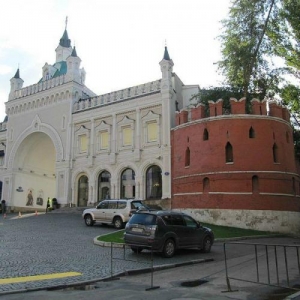Moscu +7-495-505-63-25
St. Petersburg +7-812-309-57-60
Kitai-Gorod
Excursions with Kitai-Gorod
Kitai-Gorod

Kitai-Gorod is one of the oldest historical parts of Moscow. It joins the Kremlin from the east side, and Moscow River — from the south side. In the north it borders with Okhotny Ryad, and in the north-east — with Old and New squares.
The south part of Kitai-Gorod is the oldest one. It is well known that in the 11th century it had already been inhabited. In the 14th century the territory was occupied by traders and craftsmen. The name «Kitai-Gorod» appeared in the 16th century when the craftsmen were replaced by the boyars and clergy representatives. The name has nothing to do with China, which is «Kitai» in Russian. Most probably, it comes from the old Russian word «kita» that is a bunch of poles that was used for fortification construction.
Originally, Kitai-Gorod was surrounded with earth rampart and wooden fortifications, and in 1535-1538 on their site the Kitaigorodskaya Wall was put up. By that time Kitai-Gorod along with Red Square was an important trade center of Moscow. It was also famous as the place where the Printing Typography started to function in the 16th century, and printing pioneer Ivan Fyodorov worked. At the end of the 17th century in Kitai-Gorod the Mint was opened, and in 1687 the Slovenian-Greek-Latin Academy that was the prototype of the University was founded in the monastery of Our Savior Behind the Icons.
In 1812 when Moscow was captured by the army of Napoleon, Kitai-Gorod burnt down. When the city was set free and reconstruction works started, Kitai-Gorod was built up with stone constructions.
At the end of the 19th-the beginning of the 20th century Kitai-Gorod became a business center of Moscow. It was the place where banks, the Exchange, and trade centers were located. Elegant many-storied buildings in the Art Nouveau style were constructed for some of them. Nikolskaya Street of Kitai-Gorod was the center of book trade. The largest in the city Sytin's bookstore was also located there.
At the end of the 19th century the Upper and the Middle trade rows were put up. Today on the site of the Upper rows the GUM Department Store is located. The Lower trade rows that existed in Kitai-Gorod since the 17th century were repeatedly rebuilt, and finally demolished.
During the time of Soviet power, Kitai-Gorod was reconstructed several times. The tumbledown buildings were pulled down, the narrow lanes were broadened, and the metro stations were constructed. Nowadays Kitai-Gorod ranges among the nine «preserving zones» that were created by the government decision. It is not allowed to put up new constructions in Kitai-Gorod. The restored old mansions and churches are used as museums, concert halls, and other cultural institutes.
Nearest hotels
Ararat Park Hyatt
Calle Neglinnaya, 4
El edificio moderno del hotel Ararat Park Hyatt, que representa en Rusia la famosa red internacional Hyatt, se sitúa
de 117.98
por noche
Metropol
Av. Teatralny, 1/4
Este hotel fue fundado por el famoso empresario y mecenas de Moscú Sava Mamonov y fue el primer hotel de primera
de 124.53
por noche
Savoy
Calle Rozhdestvenka, 3
El hotel de cinco estrellas Savoy ofrece una variedad de servicios y comodidades para los turistas y hombres de
de 0
por noche
Salut
158 Leninsky Pr.
Salut hotel is located in South-West part of Moscow at the intersection of Leninsky and Vernandsky prospects, within
de 0
por noche
Bentley
28/6 build. 3 Pokrovka St.
The Bentley hotel is located in the center of Moscow, on a historic street, not far from the Kremlin and Red Square.
de 0
por noche
Atracciones de Moscu
- Monuments
































